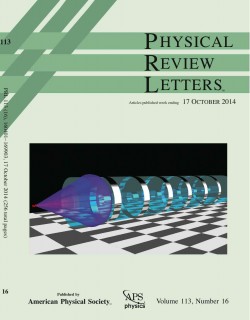Publication on Cherenkov radiation selected as cover story of Physical Review Letters

Particle physicists have a hard job in identifying the elementary particles created in their accelerators. But now researchers from Belgium and Sweden have designed an artificial material that makes it easier to distinguish these particles.
A sonic shock wave is formed around an object that breaks the sound barrier. Similarly, a particle that travels faster than light in a transparent material creates a cone of light around itself. This light cone is called Cherenkov radiation.
Amongst others, Cherenkov radiation is utilized by particle physicists when examining the smallest constituents of matter. The angle of the light cone, i.e., its sharpness, provides a measure of the velocity of the particle that generates the light. It helps physicists to identify the large numbers of common and not-so-common particles created in the violent collisions in particle accelerators.
Unfortunately, the light cone angle saturates at higher particle momenta—all particles with large momentum generate light cones with the same angle. Hence, these particles are indistinguishable.
But now researchers at the Free University of Brussels and Chalmers University of Technology have designed a material that manipulates the Cherenkov radiation so that particles with high momentum get a distinct angle of the light cone. The work is reported in the journal Physical Review Letters.
- “The result is that even particles with large momentum can be more efficiently separated and identified,” said Philippe Tassin.
The method used to design the new material is known as transformation optics. It is a fairly new and very fruitful combination of the tools of Einstein's theory of relativity and optics, and was previously used to construct invisibility cloaks and table-top black-hole absorbers.
Carefully calculated variations of the material's refractive index causes the light to experience the material as curved and, therefore, it behaves differently from what we are used to. In the anisotropic material, Cherenkov radiation experiences the material as stretched in two different directions, which gives rise to light cones with distinct angles.
Through this work, Vincent Ginis and his colleagues also demonstrated more in-depth opportunities with transformation optics.
- “This far, transformation optics has mainly concerned changing light ray trajectories through a material. Now we show that it is also possible to influence the generation of light. As an example, we have solved the problem of Cherenkov light cones for particles of large momentum,” explains Philippe Tassin.
Image caption: The figure shows the Cherenkov light cone created by particles moving through a specially designed metamaterial. The material consists of silver cylinders of a few tens of nanometers thick embedded in a nonconductive material. The checkerboard illustrates the coordinate transformation used to enhance the sensitivity of Cherenkov particle detection by the metamaterial.
Reference: http://journals.aps.org/prl/abstract/10.1103/PhysRevLett.113.167402